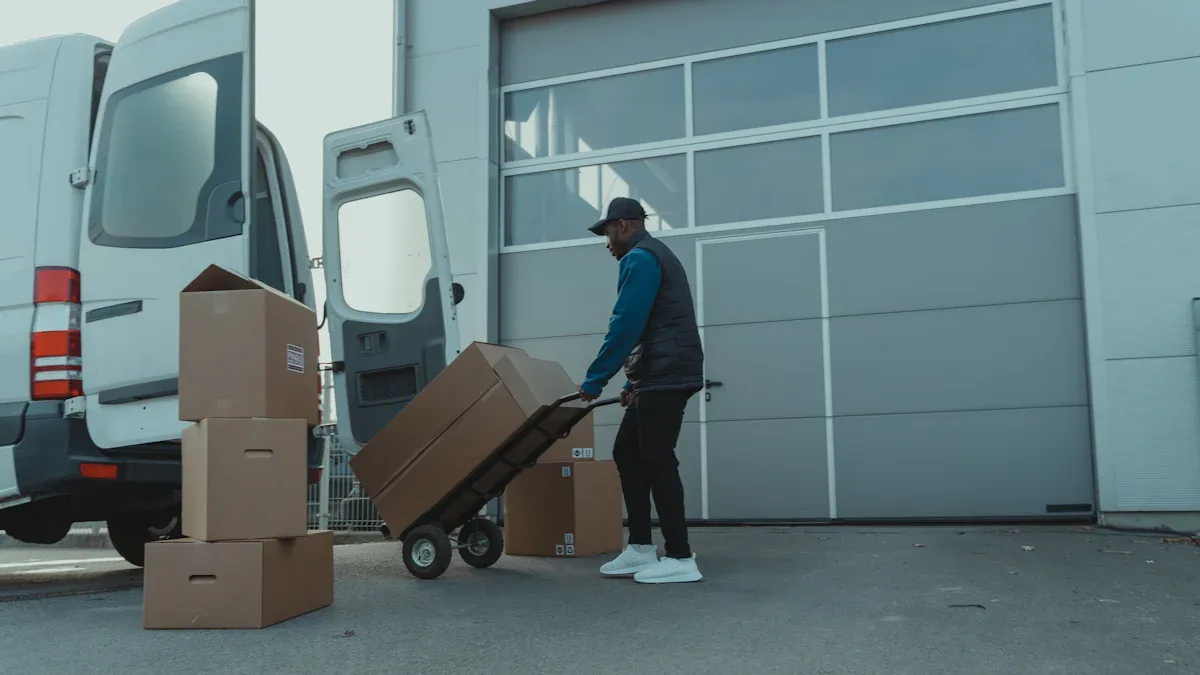Route-Optimization 101: Algorithms Behind Faster Delivery

Route-Optimization 101 is the process of determining the most efficient routes for deliveries. It helps you reduce travel time, cut costs, and improve overall efficiency. In industries like e-commerce and logistics, its impact is undeniable. For instance:
The market for route-optimization software is projected to grow from $3,729 million to $12,416 million by 2030.
Businesses using route-optimization have achieved up to a 27% reduction in distance traveled and a 20% decrease in fuel costs.
With tools like GPS tracking and automation, route-optimization has become essential for staying competitive in today’s fast-paced delivery landscape.
Key Takeaways
Route optimization saves time and money, making deliveries faster.
Algorithms like Dijkstra’s and genetic ones find the best routes.
Real-time updates help adjust routes for traffic and changes quickly.
Better routes make customers happy with on-time and correct deliveries.
Using AI and machine learning makes planning smarter and eco-friendly.
Route-Optimization 101: What It Is and Why It Matters
Definition and Core Principles
Route optimization is the process of finding the most efficient paths for deliveries. It ensures that drivers cover the shortest possible distance while meeting delivery requirements like time windows and customer preferences. This process relies on several core principles:
Principle | Description |
|---|---|
Understanding Patterns | Delivery points are not random. Identifying hotspots helps streamline routes. |
Traffic Considerations | Traffic changes throughout the day. Factoring this in improves route efficiency. |
Holistic Supply Chain Approach | Optimizing the entire fleet and recurring deliveries ensures better overall performance. |
By applying these principles, businesses can save time, reduce costs, and improve delivery accuracy. For example, companies like UPS use advanced systems like ORION to optimize routes, saving millions in fuel costs annually.
Challenges in Delivery Logistics Addressed by Route Optimization
Delivery logistics face several challenges that route optimization can solve:
Address Inaccuracy: Incorrect or incomplete addresses waste time and fuel. Precise geocoding minimizes these issues.
Traffic and Dynamic Changes: Traffic jams and road closures disrupt schedules. Real-time updates help drivers avoid delays.
Capacity Utilization: Poorly planned routes lead to underutilized vehicles and driver burnout. Optimized routes balance workloads effectively.
Consider these examples:
UPS reduced fuel consumption by 10% and cut 10 million miles annually through advanced route optimization.
FedEx decreased delivery times by 25% using dynamic routing systems.
Instacart improved on-time deliveries by 20% with demand-based route planning.
These improvements highlight how route optimization addresses inefficiencies and enhances delivery performance.
Importance in the On-Demand Economy
The on-demand economy thrives on speed and convenience. With over 22.4 million customers spending $57.6 billion annually, businesses must meet high expectations for fast and reliable deliveries. Route optimization plays a critical role in achieving this by:
Reducing travel times by up to 20% with real-time traffic updates.
Increasing on-time delivery rates to as high as 98%.
Enhancing customer satisfaction by offering flexible delivery options.
For instance, Amazon uses dynamic route optimization to adapt to real-time factors, ensuring efficient deliveries. This approach not only improves customer loyalty but also reduces operational costs.
In today’s fast-paced world, route optimization is no longer optional. It’s a necessity for businesses aiming to stay competitive and meet the demands of the on-demand economy.
Algorithms Behind Route Optimization

Common Algorithms (e.g., Dijkstra’s Algorithm, Genetic Algorithms)
Route optimization relies on powerful algorithms to calculate the most efficient paths. Each algorithm has unique strengths, making it suitable for specific scenarios. Here are some commonly used ones:
Algorithm | Application Area | Performance Metrics Description |
|---|---|---|
Bus transit optimization | Optimizes routes to minimize fuel, distance, and time, with various crossover techniques evaluated. | |
Crossover Techniques | Bus transit optimization | Seven crossover methods tested, with PBX + OX1 found to be the most effective in real-world scenarios. |
Construction site path planning | Evaluates paths based on transportation and safety-related costs, focusing on distance and visibility. | |
A* | Construction site path planning | Similar to Dijkstra, with additional heuristics for optimization. |
Genetic Alg. | Construction site path planning | Multi-objective optimization for path selection, balancing multiple criteria. |
For example, Dijkstra’s algorithm is ideal for finding the shortest path in static networks, such as construction sites. On the other hand, genetic algorithms excel in complex, multi-objective problems like bus transit systems. By understanding these algorithms, you can choose the right one for your delivery needs.
Role of Constraints in Route Optimization
Constraints play a critical role in route optimization. They define the rules that algorithms must follow to create practical and efficient routes. Common constraints include time windows, vehicle capacity, and delivery precedence.
Machine learning has proven effective in identifying hidden constraints in vehicle routing problems. For instance, models trained to classify routes based on time windows or capacity can reveal which constraints are harder to recognize. This insight helps improve algorithm performance.
When you incorporate constraints into route planning, you ensure that the solutions are not only efficient but also realistic. For example, a delivery route that ignores vehicle capacity may lead to overloaded trucks, causing delays and customer dissatisfaction.
Real-Time vs. Static Optimization
Route optimization can be either static or real-time. Static optimization plans routes in advance, while real-time optimization adjusts them dynamically based on current conditions.
Metric | Static Optimization | Dynamic Optimization |
|---|---|---|
Computational Intensity | Up to 30% less | N/A |
N/A | 22% | |
Average Cost Savings | N/A | 19% |
Efficiency Compared to Human Planners | N/A | Up to 40% more |
Importance for Network Performance | 92% | N/A |
Real-time optimization offers significant advantages, especially in unpredictable environments. For example, it can reduce travel distances by 22% and improve efficiency by up to 40% compared to human planners. However, static optimization remains valuable for predictable scenarios, such as recurring delivery schedules.
By combining both approaches, you can achieve a balance between computational efficiency and adaptability. This hybrid strategy ensures that your delivery operations remain efficient, even in the face of unexpected challenges.
Benefits of Route Optimization
Cost and Time Efficiency
Route optimization significantly reduces operational costs and saves time. By planning the most efficient paths, you can minimize fuel consumption and vehicle wear and tear. This leads to lower maintenance expenses and a reduced total cost of ownership (TCO).
Metric | Description |
|---|---|
Real-time tracking | Enables continuous monitoring of routes and adjustments based on current conditions. |
Fuel efficiency | Optimizes fuel consumption by planning the most efficient paths, reducing overall costs. |
Maintenance costs | Effective route planning can lead to lower wear and tear on vehicles, thus reducing maintenance expenses. |
Total cost of ownership (TCO) | Considers all costs associated with vehicle operation, which can be minimized through route optimization. |
For example, companies using route planning software report a 20-25% improvement in fleet productivity. Additionally, integrating live traffic updates can reduce delivery delays by up to 30%. These improvements not only save money but also enhance operational efficiency.
Enhanced Customer Satisfaction
Route optimization directly impacts customer satisfaction by improving delivery accuracy and reliability. When you deliver orders on time and to the correct address, customers are more likely to trust your service.
Customer Satisfaction Score: Measures customer feedback on service quality after visits, essential for evaluating the impact of route optimizations.
Improved Delivery Accuracy: Ensures correct order delivery, often verified through proof of delivery methods like photos or signatures, which reduces errors.
Precise route planning can increase on-time deliveries by over 90%. This reliability builds customer loyalty and enhances your brand reputation. Additionally, optimized routes allow for flexible delivery options, further improving the customer experience.
Environmental Sustainability
Route optimization contributes to a greener planet by reducing fuel consumption and emissions. Efficient routes lower the amount of fuel used, which directly translates to a smaller carbon footprint.
Route optimization can reduce fuel consumption by up to 20%.
Decreased emissions lead to a smaller carbon footprint.
Efficient routes help reduce traffic congestion, further lowering fuel usage and emissions.
AI-powered route optimization also helps logistics companies meet regulatory requirements concerning emissions. By adopting these strategies, you not only save costs but also contribute to environmental sustainability. This dual benefit makes route optimization a win-win for businesses and the planet.
Real-World Applications of Route Optimization

E-Commerce and Last-Mile Delivery
In e-commerce, last-mile delivery is one of the most critical stages of the supply chain. It directly impacts customer satisfaction and operational costs. Route optimization tools analyze traffic patterns, delivery locations, and time windows to create efficient delivery plans. These tools reduce delivery times and costs while improving service reliability.
For example, adopting last-mile optimization software can improve service recovery rates by up to five times compared to traditional methods. Real-time communication tools enhance customer satisfaction by reducing missed deliveries, with 73% of consumers reporting that delivery experience influences their purchasing decisions. Optimized routing also lowers operational costs, as fuel expenses account for 30% of last-mile delivery costs.
Application | Outcome Description | Statistical Evidence |
|---|---|---|
Last-Mile Optimization Software | Improved service recovery rates | 5x faster service recovery rates compared to end-of-day reporting (2022 Gartner Supply Chain Benchmark) |
Real-Time Communication | Enhanced customer satisfaction and reduced missed deliveries | 73% of consumers influenced by delivery experience (2023 Capgemini Research Institute) |
Optimized Routing | Significant drop in missed deliveries and reduced operational costs | Fuel costs reduced by optimizing routes, accounting for 30% of last-mile delivery costs |
Automated Delivery Orchestration | Reduction in back-office staffing needs without impacting delivery volume | 38% reduction in staffing needs reported by a logistics provider using automated tools |
Food Delivery and Dynamic Routing
Dynamic routing has revolutionized food delivery services. It allows you to adjust delivery routes in real time based on traffic, weather, and order volume. This ensures that food arrives fresh and on time, enhancing the customer experience.
Key performance indicators validate the benefits of dynamic routing. Delivery time accuracy improves, ensuring orders meet scheduled times. Fuel consumption decreases as routes become more efficient. Total distance traveled reduces, and vehicle utilization increases, maximizing the efficiency of your fleet. These improvements lead to higher customer satisfaction levels, making dynamic routing a game-changer for food delivery businesses.
Performance Indicator | Description |
|---|---|
Delivery Time Accuracy | Measures how accurately deliveries meet scheduled times. |
Fuel Consumption | Assesses the efficiency of fuel usage during deliveries. |
Total Distance | Evaluates the total distance traveled for deliveries. |
Vehicle Utilization | Indicates how effectively vehicles are used for deliveries. |
Customer Satisfaction Levels | Reflects the overall satisfaction of customers with the service. |
Logistics and Freight Management
In logistics and freight management, route optimization ensures timely deliveries, cost efficiency, and sustainability. By minimizing fuel consumption and labor costs, you can significantly reduce operational expenses. Optimized routes also improve delivery performance, ensuring goods reach their destinations on time.
Route optimization minimizes fuel consumption and lowers labor costs.
It enhances delivery performance, ensuring timely deliveries and boosting customer satisfaction.
Sustainability improves through reduced fuel usage and lower carbon emissions.
These benefits make route optimization a cornerstone of modern logistics. It not only streamlines operations but also aligns with environmental goals, making it a win-win for businesses and the planet.
Future Trends in Route Optimization
AI and Machine Learning in Route Planning
Artificial intelligence (AI) and machine learning are transforming how you approach route planning. These technologies analyze vast amounts of real-time data to create highly accurate and efficient delivery routes. For example:
They integrate traffic patterns, weather conditions, and delivery time windows to optimize routes.
Predictive analytics anticipates demand spikes, helping you proactively plan routes.
AI-driven systems incorporate sustainability metrics, reducing fuel consumption and carbon footprints.
These advancements also enhance customer experiences. Tailored delivery windows and dynamic updates keep customers informed and satisfied. By adopting AI and machine learning, you can stay ahead in the competitive delivery landscape.
Predictive Analytics for Proactive Optimization
Predictive analytics takes route optimization to the next level by using historical and real-time data to foresee challenges. Companies like Uber Eats rely on this technology to improve order accuracy and optimize delivery routes. Predictive models analyze traffic patterns, weather, and delivery schedules to enhance efficiency.
Many logistics companies now use machine learning to streamline operations. This approach reduces forecasting errors by up to 50% and improves logistics costs by 15%. By leveraging predictive analytics, you can proactively address potential delays and ensure smoother delivery operations.
Autonomous Vehicles and Their Role
Autonomous vehicles are set to revolutionize delivery systems. These vehicles use AI to navigate routes, avoid obstacles, and adapt to real-time changes. They excel in last-mile delivery, where efficiency is crucial.
According to Gartner, over 75% of supply chain management applications will incorporate AI by 2026. Early adopters of autonomous technologies have already seen significant improvements in service levels and cost efficiency. By integrating autonomous vehicles into your fleet, you can reduce labor costs, improve delivery speed, and contribute to sustainability goals.
Route-Optimization 101 has reshaped delivery systems by improving efficiency, reducing costs, and enhancing customer satisfaction. Advanced algorithms and AI-driven tools have unlocked new possibilities, enabling real-time adjustments and predictive planning. For example:
AI systems optimize routes using live GPS data, saving time and fuel.
Predictive analytics prevent delays by analyzing historical traffic patterns.
UPS’s AI-driven initiative reduced emissions and shipping costs, benefiting sustainability and profitability.
When choosing optimization tools, prioritize features like geospatial analysis, scalability, and user-friendly interfaces. Adopting AI-powered solutions ensures your business stays competitive while meeting modern delivery demands.
FAQ
What is the difference between route optimization and route planning?
Route planning focuses on creating a basic delivery route. Route optimization takes it further by finding the most efficient path, considering factors like traffic, delivery time windows, and vehicle capacity. Optimization ensures cost savings and faster deliveries.
How does route optimization software work?
Route optimization software uses algorithms to analyze delivery points, traffic data, and constraints like time windows. It calculates the best routes for your fleet in seconds. Many tools also provide real-time updates to adapt to changing conditions.
Can small businesses benefit from route optimization?
Absolutely! Route optimization reduces fuel costs, saves time, and improves customer satisfaction. Even small businesses can use affordable tools to streamline deliveries and compete with larger companies. It’s a smart investment for growth.
Is real-time optimization necessary for all businesses?
Not always. Real-time optimization is ideal for businesses with unpredictable conditions, like food delivery or same-day shipping. Static optimization works well for predictable schedules, such as recurring deliveries. Choose based on your business needs.
Does route optimization help reduce environmental impact? 🌍
Yes! Efficient routes lower fuel consumption and emissions. By optimizing deliveries, you contribute to sustainability while saving money. Many companies use this as part of their green initiatives to meet environmental goals.
See Also
Effective Strategies for Retail Demand Forecasting Each Week
Why Need-Based Recommendations Outperform Traditional Buying Lists
Understanding Short-Term Demand Forecasting Techniques and Challenges
